I call it stew but Japanese Meat and Potato Stew is nowhere near the Western style stew. The cooking liquid is based on the usual Japanese flavours of slightly sweetened soy sauce with dashi stock, but is not thickened. It is perhaps closer to Irish stew with Japanese style broth.
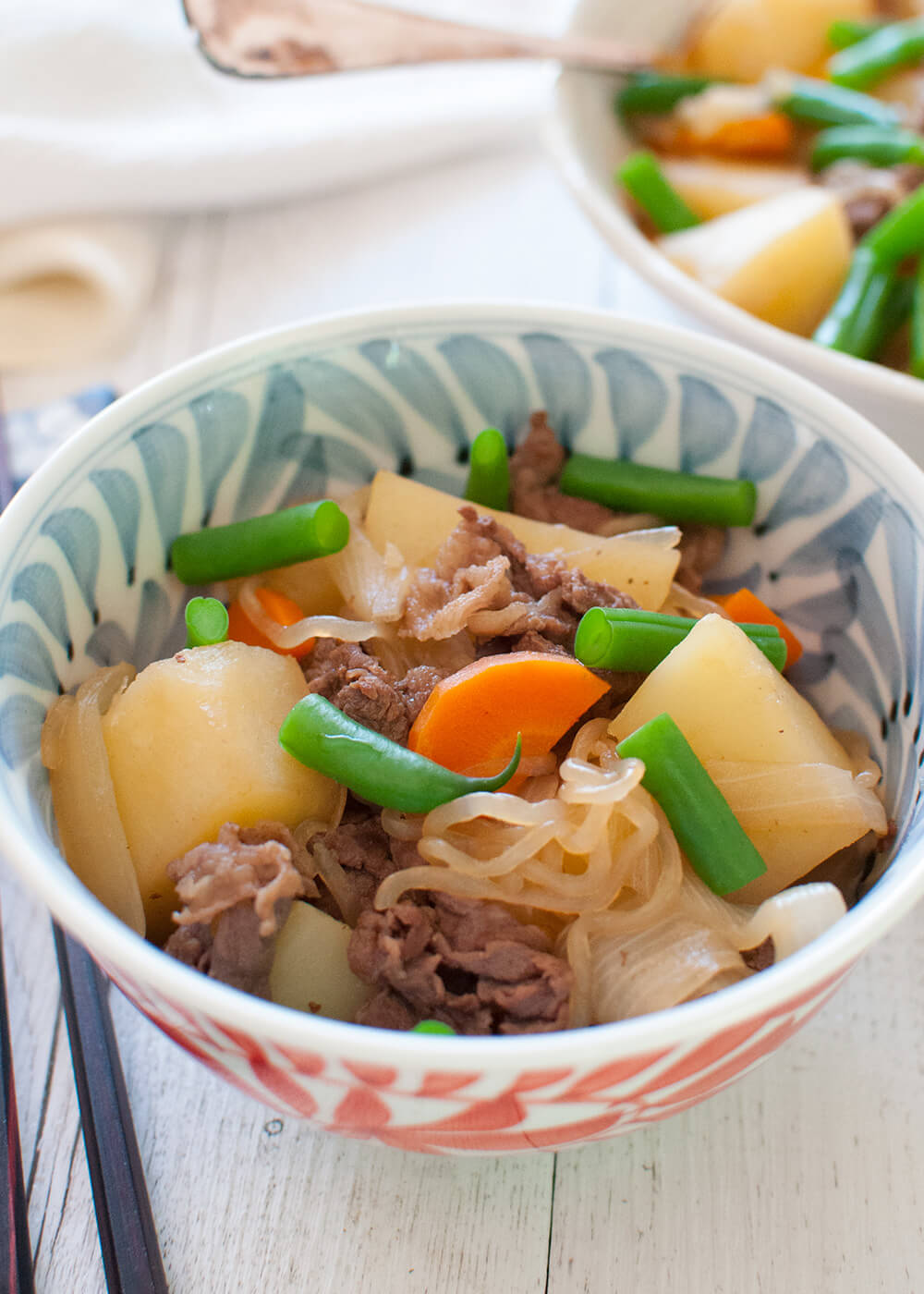
This stew is called ‘nikujaga’ (肉じゃが) in Japanese, which literally means meat and potatoes – the key ingredients of this dish. Meat is ‘niku’ (肉) in Japanese and potato is ‘jagaimo’ (じゃがいも). But instead of calling it ‘nikujagaimo’, the word for potato is shortened to ‘jaga’. Come to think of it, I think Japanese is good at shortening words to make them catchy.
There is a serious debate over whether or not the meat should be beef or pork. Some people did a survey on this and found out that the meat preference is clearly divided into the eastern region and the western region, separating the main land Honshu in the middle. People from the western part of Japan prefer sliced beef while the people from the eastern part of Japan use sliced pork.
The only exceptions to this are Okinawa and a couple of prefectures in Kyushu that are close to Okinawa and use pork. This is understandable as Okinawa = pork dishes.
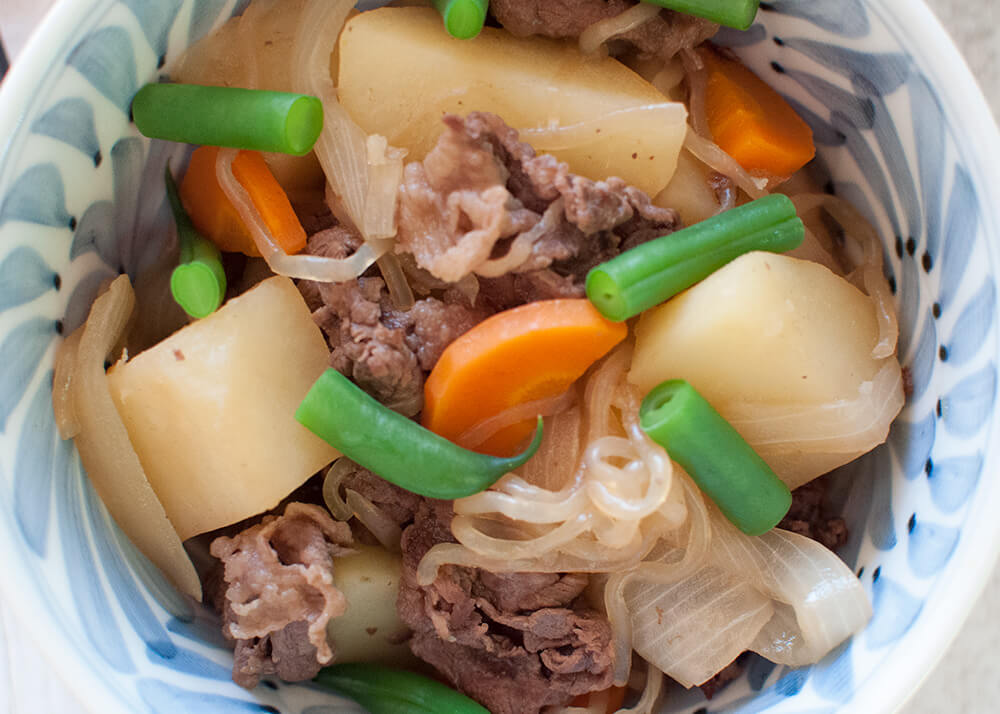
I am from Tokyo which is considered to be the eastern part of Japan but I don’t have a particular preference. I just use whichever meat is at hand.
The story about how nikujaga was invented is quite fascinating. It was the late 19th century. The chef of the Imperial Japanese Navy was asked by the then Marshal-Admiral, Heihachirō Tōgō to make a beef stew that he became fond of while studying in Portsmouth, England. Since the chef had never seen the beef stew, nor tasted it, he made it up using typical Japanese flavouring and that’s how nikujaga was invented.
Given the fact that beef stew was already on restaurant menus at the time, this does not seem to be a true story. However, the city of Maizuru in Kyoto prefecture and subsequently the city of Kure in Hiroshima prefecture both declared that they were the place where nikujaga was created and Heihachirō Tōgō was once stationed in both places. So nikujaga must be somewhat related to Tōgō.
In addition to meat and potatoes, sliced onions and carrots are the minimum ingredients to make nikujaga. Often, konnyaku yum noodles called shirataki (please visit the post Sukiyaki to see more photos of shirataki) are also added to it.
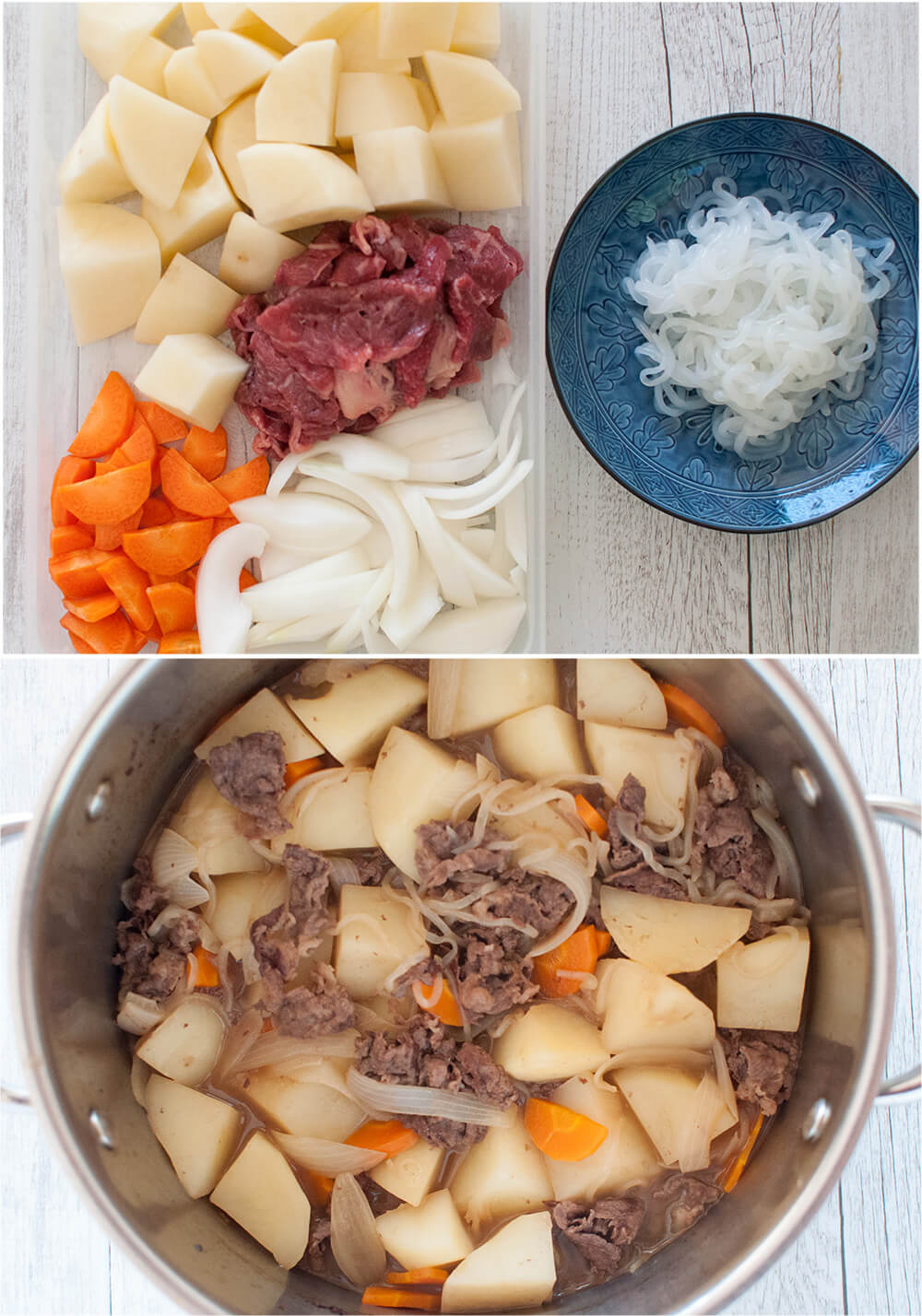
The flavouring is the usual Japanese flavouring consisting of dashi stock, soy sauce, mirin, sake and sugar. The ingredients are lightly sautéed first, then cooked in the flavoured broth. When the potatoes are cooked through, it is ready to serve.
The colour of carrot gives nikujaga, which is otherwise a brown dish, a bit of colour but I tend to add something green as garnish. Green vegetables that go very well with nikujaga include green beans, snow peas and peas.
If you are adding green beans, blanch them and then cut into about 3cm long. Snow peas also need to be blanched. Use them as is or if large, cut them in half diagonally. As for peas, I usually use frozen peas by quickly boiling them to defrost and warm up. Scatter them after plating nikujaga.
Today, I used sliced beef for nikujaga but if you prefer pork, simply replace the beef in the recipe with pork. Regardless of the type of meat you use, it is important to use thinly sliced meat as the cooking time is very short and the stewed meat needs to become tender in a short period of time.
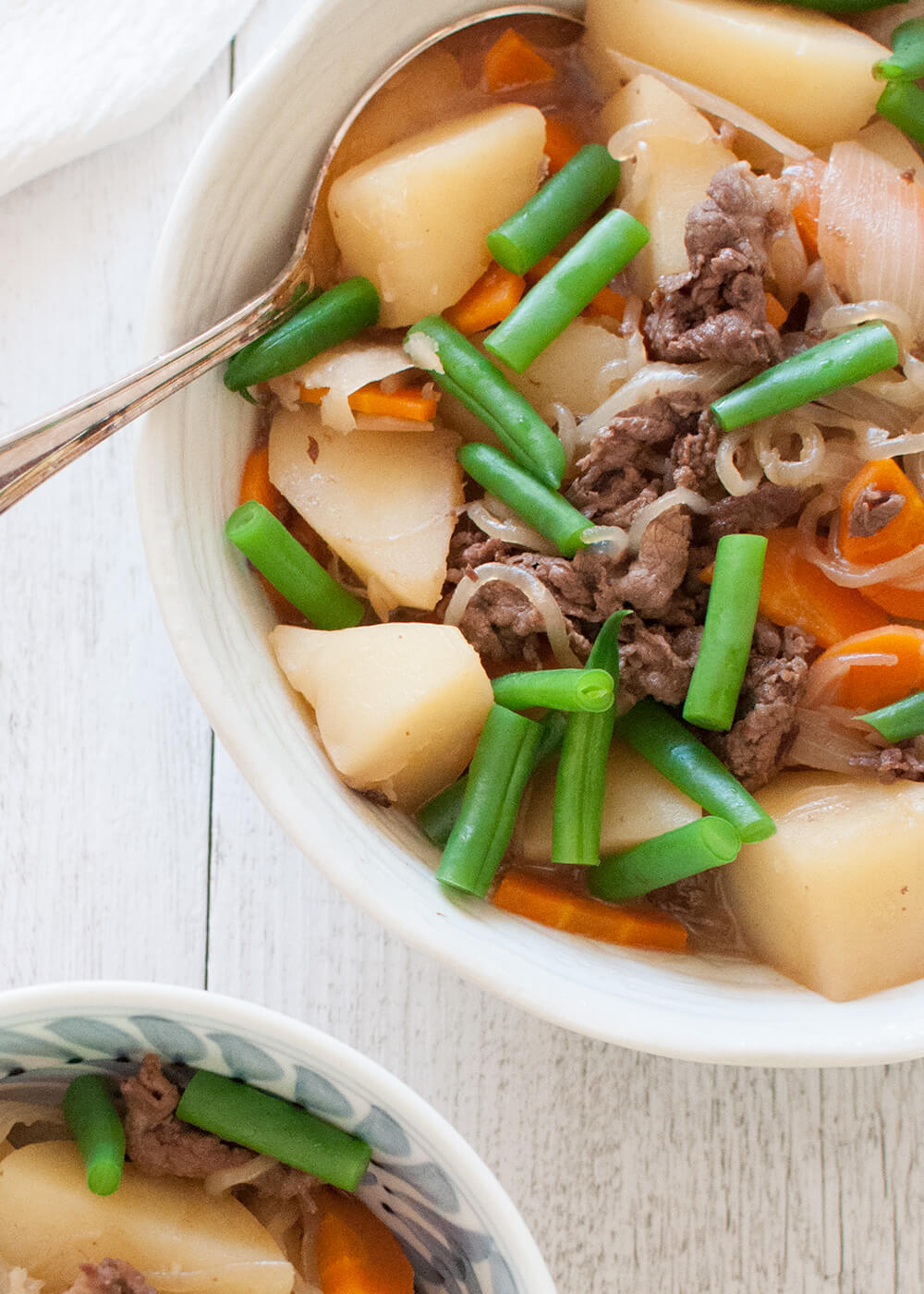
Nikujaga is considered to be a representative home cooking dish. It is even said that nikujaga is the taste of mum’s cooking and perhaps because of this, many Japanese men seem to like nikujaga (don’t ask me why only men). Come to think of it, my father liked it and my son likes it more than I do.
As long as the meat is not for stewing (because you don’t cook the meat for a very long time) and is very thinly sliced, any part of meat can be used for this dish. You will be surprised to learn that it is so simple to make but so tasty and filling.
Yumiko![]()
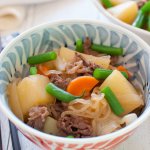
I call it stew but Japanese Meat and Potato Stew is nowhere near the Western style stew. The flavour is based on the usual Japanese flavour of slightly sweetened soy sauce with dashi stock and the sauce is not thickened. It is perhaps close to Irish stew with Japanese style broth.
- 200 g thinly sliced beef (note 1)
- 2 potatoes (about 600g), cut into 3-4cm cubes (note 6)
- 120 g onion , sliced into 1cm wide
- 60 g carrot thinly sliced into 4-5mm thick , then cut in halves or quarters (note 2)
- 100 g shirataki (konnyaku yum noodles) cut into long strands about 10cm long (note 3)
- 1 tbsp oil
- 350 ml dashi stock
- 2 tbsp cooking sake
- 1/2 tbsp mirin
- 2 tbsp soy sauce
- 1 tbsp sugar
- 50 g green beans , blanched and cut into 3cm long (note 4)
-
If each slice of beef is large, cut it into large bite-size pieces.
-
Add oil to a saucepan and heat over medium high heat. Sauté meat, breaking the meat pieces apart.
-
When the meat changes colour to dark brown, add vegetables including shirataki and cook further 1 minute ensuring that all vegetable pieces are coated with oil.
-
Add dashi stock and bring it to a boil. Remove scum using a ladle, then add sake, mirin and sugar.
-
Once boiling again, bring the heat down to low, add soy sauce and place a drop lid (note 5). Cook for about 10 minutes until potatoes are tender (put a thin bamboo skewer into a piece of potato and if it gets through easily, potatoes are cooked).
-
Transfer the nikujaga to a serving bowl, scatter the green beans and serve while hot.
1. Instead of beef, you can use pork slices. If you can buy sliced beef or pork, that would be the easiest. They are sold at Asian/Japanese butcher and grocery stores.
You can also slice a block of meat thinly yourself - please visit my post Beef Rolls with Asparagus.
2. My carrot was very thin, so I cut it in half to make semi-circle pieces. If the carrot is thick, cut it into quarters to make wedge-shaped pieces.
3. You can buy shirataki at Japanese/Asian grocery stores. Please visit my post, Sukiyaki for more details about shirataki with photos.
4. Instead of green beans, you can use blanched snow peas or frozen peas that are boiled to warm up.
5. A drop lid is called 'otoshibuta' (落し蓋) in Japanese. It is a round lid that is slightly smaller than the opening of a saucepan. It is traditionally made of wood but I have a stainless steel lid. It is placed on top of the ingredients in a pot to ensure the heat is evenly distributed, ingredients cook faster, and stay in place without breaking apart. It also stops the liquid from evaporating quickly.
If you don’t have a drop lid, you can make one with aluminium foil. Cut a square foil, fold the edges to make it a round shape with the diameter slightly smaller than the pot. Then poke the foil with a knife or a chopstick to make holes in several places.
6. Potatoes suitable for stewing like Nikujaga are waxy potatoes or all rounder potatoes. Starchy potatoes do not hold the shape together when cooked and should be avoided for this dish.
Yumiko-san, just wondering if the recipe calls for cooking sake or drinking sake. I am planning to make this on the weekend 🙂
Hi V, use cooking sake as it is cheaper. Thanks for asking. I just updated the recipe and it now links to Glossary where you can find more details about it.
Nikujaga is a heart-warming dish. I hope you enjoy it!
I just wanted to drop in here and say thank you for this wonderful blog. I really enjoy your recipes. What a great legacy! You’re doing a great job!
Hi Melissa, thank you!
Is the amount of dashi correct? I made the recipe today, and had to stop pouring the dashi in half way, because it seemed like it was way too much.
Hi Sara, it should be. My Nikujaga finishes with a bit of liquid, though.
Yumiko San,
I could understand when to put it in, but your instructions leave out when to pour in the soy sauce. Might want to add that so people don’t forget to add it.
I might also add a more specific description of the kind of potatoes to use. The ones I used were not quite right.
Hi David, thank you very much for letting me know. I will update the recipe asap. Potato should be for I am sorry that your potato was a wrong kind.
Hello yumiko, Thank you for publishing this recipe, I intend to do it very soon but I have some doubts: The shirataki noodles after being opened, they spoil quickly? Should I keep them in the fridge? I have also read that they have an unpleasant smell and a very elastic texture, is that true? How can I eliminate that smell?
Also, I was reading the post of dashi and I found it funny that the time left katsuobushi in the water varies a lot, I read from 10 seconds to 10 minutes, I leave it two minutes: this amount of time will make it lose a lot of flavor? (I usually do ichiban dashi and niban dashi)
Hi Ruth, you can keep sharataki for a week or so in the fridge after opening. Make sure that shirataki is submerged in water and not exposed to air. Change water every couple of days. It is true that shirataki has a unique smell. Whether or not it is unpleasant depends on individual. If it bothers you, you can boil noddles before using them to eliminate the smell. Texture of shirataki is like a hard jelly with more elasticity.
My dashi stock recipe in Home Style Japanese Dashi Stock is Awase-dashi which does not make ichiban-dashi and nib an-dashi. Awase-dashi uses up konbu and katsuobushi in one go. That’s why it cooked the ingredients for 10 minutes each. I think 10 seconds is way too short. Since you are making two batches from the ingredients, 2 minutes is right for ichiban dashi as per my other post, Varieties of Dash Stock. For niban dashi, you will need to cook longer to extract flavour. In either method, do not squeeze katsuobushi to much as the bitterness comes out and the dashi loses clarity.
Thank you so much Yumiko! My friends loved it.
Hi Lorri, wonderful. It’s good to know that the original intention of having this blog for my kids is woking and Goh made the dish without asking me!
Yumiko hallo,
I love this soup already.Thank you for sharing.
Mrs.Reitberger
Hi Mrs.Reitberger, thank you! It’s homey yummy stew.
This looks yummy! I admit that it will taste much different than beef stew that I am used to, but the seasonings sound really good. I am excited to try this one!
This looks delicious and easy..thanks
Hi Lyn, yes, simple and yummy. Also, not expensive at all. What’s more do we need ?
This looks very yummy! I love the background information and stories you tell of the dishes in your blog. I look forward to seeing your posts pop up in my mail (Nagi’s too) because I know I am going to learn some cooking and something about Japan too! Arigato gozaimasu!
Hi Lora, dōitashimashite (you are welcome)! Nikujaga is a simple but yummy heartwarming food. I hope you like it.